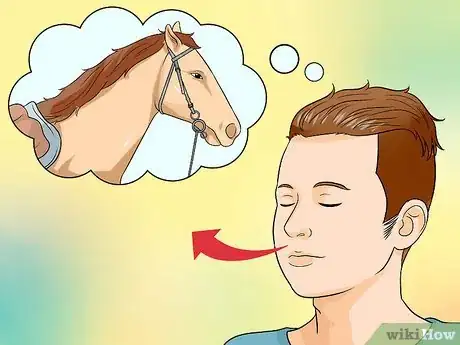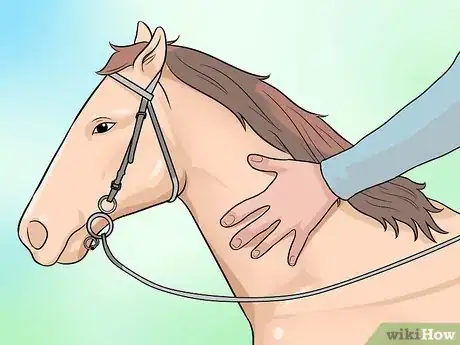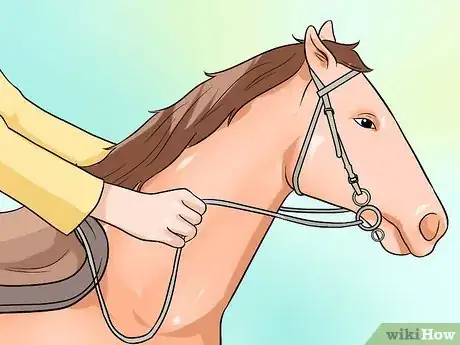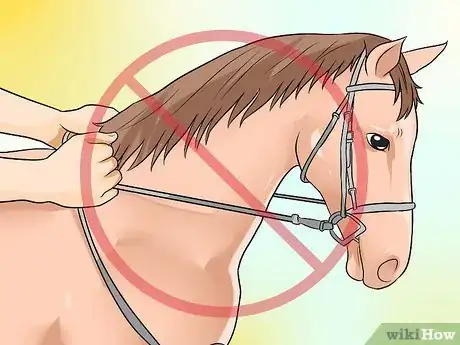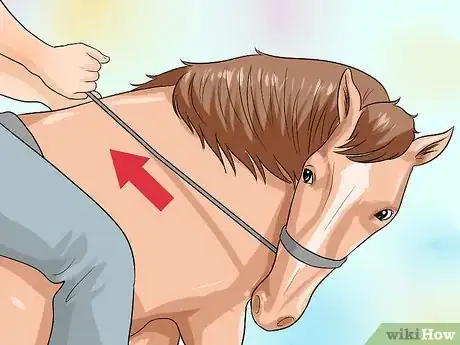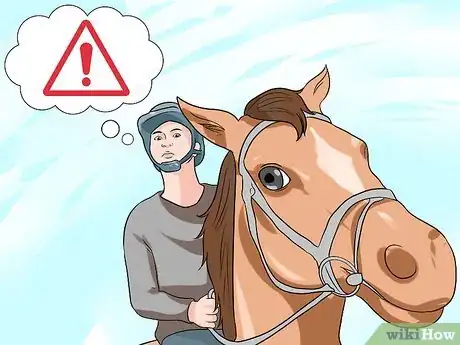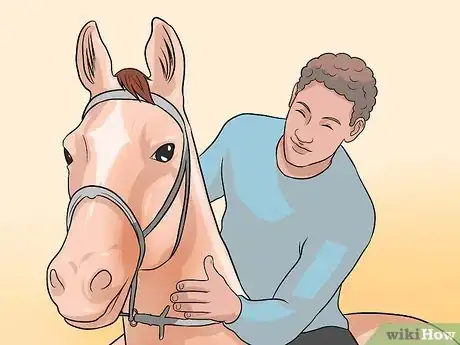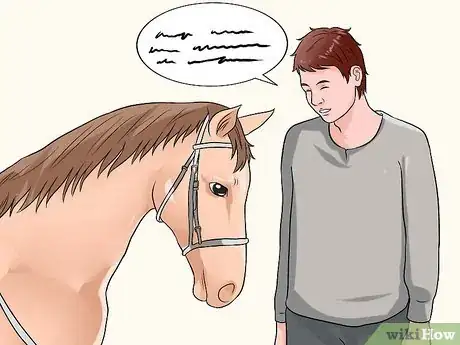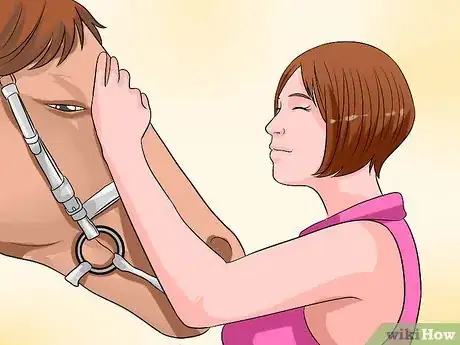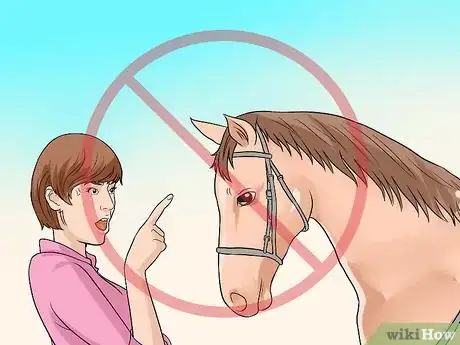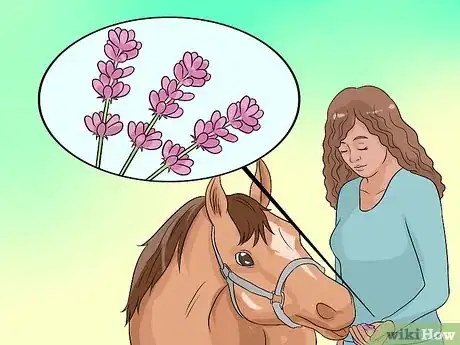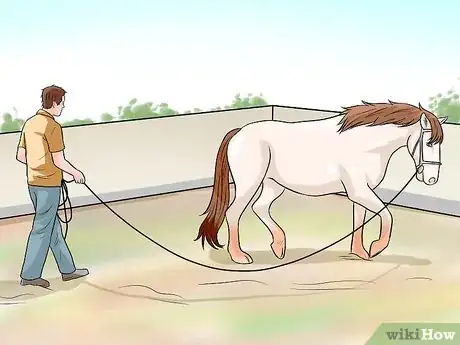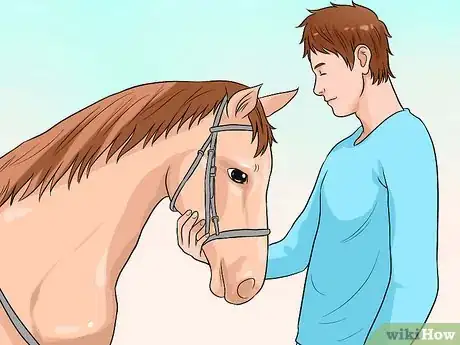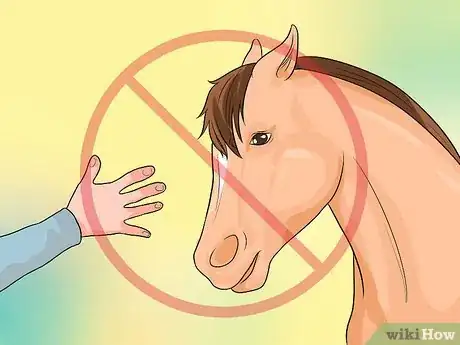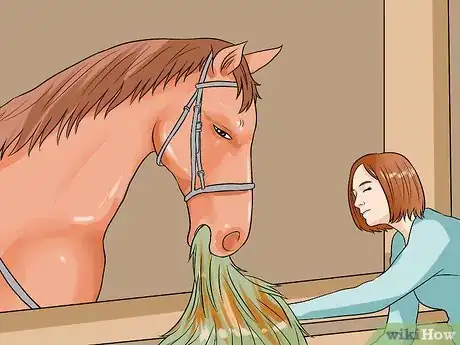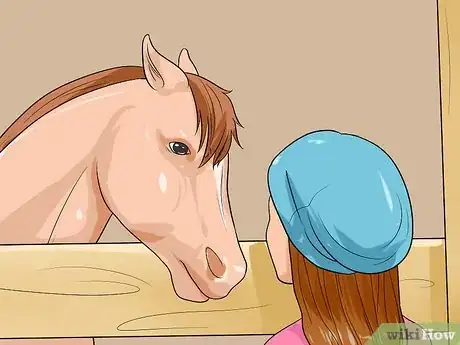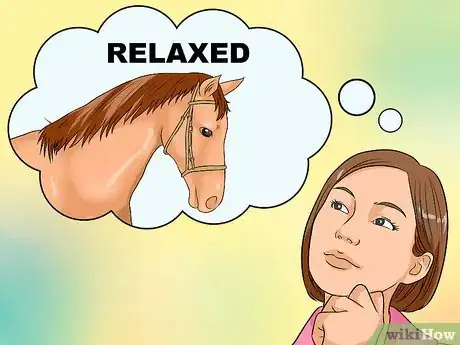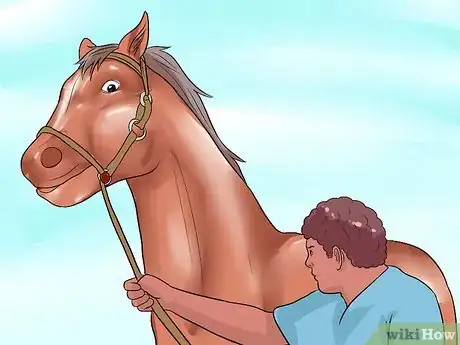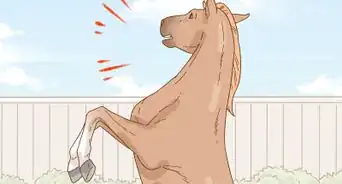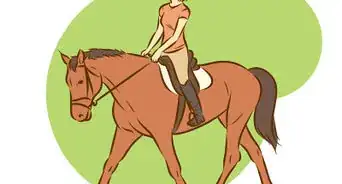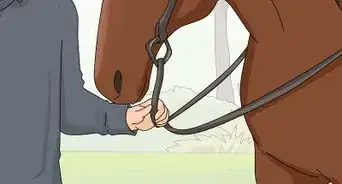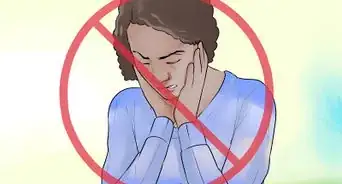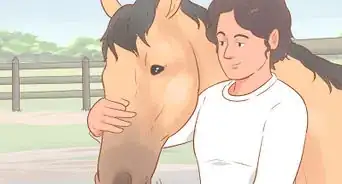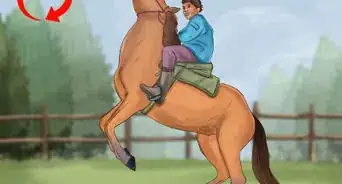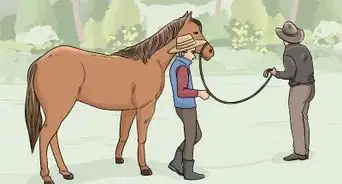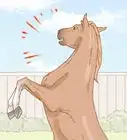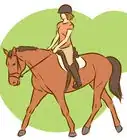This article was co-authored by Kate Jutagir. Kate Jutagir is an Equestrian Specialist, Hunter/Jumper Trainer, and the Owner of Blackhound Equestrian, a premier training barn located on 65 acres in Castro Valley, California. Originally designed to be a riding school used as a springboard for dedicated students into careers in the sport, Blackhound Equestrian has grown into a hunter/jumper training program for all levels focusing on providing a solid foundation needed for personal advancement in the sport. Kate has over 25 years of equestrian instruction and training experience. Her focus on developing horse and rider partnerships provides a complete equestrian education for both beginners and advanced riders alike.
There are 11 references cited in this article, which can be found at the bottom of the page.
wikiHow marks an article as reader-approved once it receives enough positive feedback. In this case, 89% of readers who voted found the article helpful, earning it our reader-approved status.
This article has been viewed 63,635 times.
Horses can be flighty creatures. As prey animals, they have a natural and healthy fear of unexpected smells, sounds, and movements that might signal a predator. For riders, however, a horse's fear can seem as unpredictable as it is dangerous. Spooked horses think that they are about to be harmed and do not react in a logical way -- their instinct is to flee. Nevertheless, it is possible to make a horse more calm, trusting and less likely to get spooked, but only over time. All it takes is patience and poise.
Steps
Controlling the Horse in the Saddle
-
1Keep yourself calm. Riders can get nervous before shows, and this in turn can make the horse nervous. Take a moment to breathe and relax. Remember also, again, that the horse can read your mood and emotions.[1] It is your job as a rider to be the leader. You have to be confident and guide your horse.
-
2Pet the horse's mane. If you are already on the horse, pet its neck or massage and scratch the area around its hairline on its neck. You can also rub the horse below its ears. Try different techniques until you find the one that works best for you. A good technique is T-Touch – that is, moving your middle and pointer fingers in small circles around the horses body. This will help to ease the horse's tense muscles and calm it.[2]Advertisement
-
3Ride on a loose rein. A causal or loose rein is held in one hand, with elbow mostly straight and close to the mane. This requires experience on a horse. You might not feel safe without both hands on the rein or holding it close to your body. However, using two hands on the reins engages the horse's hindquarters and adds power to whatever they are doing. You have to remember that you are sitting on top of a prey animal! The most important thing is keeping the horse calm and assured. Use one rein for control to disengage the hindquarters.
-
4Don't pull on the reins. If your horse starts to spook, your first reaction will be to hold on tighter. Resist this feeling. Do not immediately pull back on the reins, as it can worsen the situation. The horse may react as if it is being attacked and fall into a total panic.
-
5Use indirect rein in cases of mild spook, instead. Indirect rein is a technique that will stop the horse's forward motion and turn it, allowing the horse to circle and have some time to calm itself. You can do this by taking the rein in one hand and pulling back, inward, in the direction of the horse's outside hip. The rein will not cross over the neck but lay against it and apply small pressure to the animal's mouth.[3]
-
6Use lateral flexion in serious cases of spook. If the horse starts to buck, rear, or run, you may need to use something called lateral flexion and achieve a “one-rein stop.” Unlike indirect rein, this is a direct rein technique that stops the horse's feet when the animal is ready to stop – it does not force it to stop. With the “one-rein stop” you will need to shorten one rein smoothly and force the horse into a tight circle. Remaining centered and balanced, pull the left rein until the horse's head and neck bend in that direction. Keep your forward movement. The idea is not to stop the horse immediately but to slow it. Once the horse is in the turn, it will start to calm and relax, allowing you to slow to a walk and stop. [4]
-
7Act sooner rather than later. You should act promptly if you feel the horse become tense. Stay calm. A spooked horse is a dangerous horse and how you react may save you from an injury or worse. Try to diffuse the situation and bring the horse under control, dismounting if necessary.
-
8End riding sessions on a good note. Your horse shouldn't fear the arena or get nervous whenever the saddle comes out. Don't punish the horse for an episode of spooking. This will merely frighten it and cause it to see you as a potential threat or predator.
Controlling the Horse on the Ground
-
1Approach with care. Show the horse that nothing is going to harm it. Move slowly while speaking comforting words – even though the horse might not understand you, it will be soothed by the calm sound of your voice. Keep your hands at your sides with palms facing up, as well. Be sure not to make any sudden movements.[5]
-
2Reassure the horse. If the horse shies back or to the side, continue to speak to it in soothing tones. Try to find out what has alarmed it. This should be fairly obvious as the horse will either prick his ears and either look directly at the object or shy in the opposite direction. If you can safely approach, try rubbing the gentle spot in the middle of its forehead. Horses respond positively to massages like the so-called "T-Touch." This will relax the horse.[6]
-
3Do not chastise or force the horse. Horses do not share our ability to reason. For them, an unknown shape or object signals a possible danger and is to be avoided. They won't understand that a rabbit or garden hose, for example, is not a danger. Punishing the horse or forcing it to confront what has spooked it will therefore not work, and in fact may worsen the situation, increasing the horse's fear. If you punish the horse, it may also begin to fear you.
-
4Calm the horse with an herbal remedy. Formulas made from plants like lavender, chamomile, valerian, or bach flower are favorites for calming down horses. These can also calm riders. Herbal remedies come in several forms like herbal compresses, poultices, infusions, or tinctures of alcohol, water, and plant essence; depending on type, they can be given to the horse by inhalation or ingestion in its feed. Make sure that you follow the proper instructions for how to administer the remedy. [7]
-
5Lunge the horse. Lunging is a technique in which a horse is worked around a circle on a trainer's line. It can help inexperienced horses learn to respond to voice commands and a trainer's body language and will get them used to wearing a saddle and reins and to feeling the bit. Lunging can also settle a horse before you ride it, so it is always a good idea to do so. To lunge your horse you will need good boots, a ring arena, your voice, and a long line about 30-35 feet long. The idea is to have the horse circuit the arena with the guidance of your voice and a lunging whip, changing its pace and direction. Eventually it should come to recognize your voice for walking, trotting, cantering, and other commands.
- Be sparing with the lunging whip. Cracking the whip can upset the horse, while touching it with the whip is a signal for the animal to move forward strongly.
Gaining the Horse's Trust Over Time
-
1Be calm. Horses can read your emotions. They can sense if you are agitated or angry and may become flustered. Remember that some horses will not immediately trust you and will need time, which can be weeks or even months.[8] A misstep might cause them to panic. Always approach with calmly and with confidence, not timidly or shyly.[9]
-
2Approach the horse only if it is comfortable. If its ears are pinned or its nostrils are flared, this might indicate that it is agitated by your presence. Don't approach the horse in either of those cases, because your movement might spook the animal.[10] If it is safe, approach from the left and front, if possible, speaking gently so that it is aware of your presence. Never approach the animal from behind.[11]
-
3Feed the horse. Horses learn by positive reinforcement.[12] If the horse is calm and you are able to safely approach it, feed it tidbits like carrots, apples, sugar cubes, or horse treats to help gain its trust. This sort of positive reinforcement will calm the horse and assure it that you are friendly. Repeat this step a few times and, if the horse is willing to eat, stroke its mane. Keep in mind that certain foods are not good, however. Avoid giving horses onions, potatoes, tomatoes, cabbage, or any other vegetable that causes intestinal gas or belongs to the nightshade family.[13]
-
4Visit the horse frequently. Once you have visited often enough, the horse should slowly become used to your presence and begin to trust you as a "friend.” Continue your visits to establish a steady relationship with the horse and an ever stronger bond. After a time, the horse will trust you enough to let you on its back.
-
5Try to read the horse's body language.[14] Like humans, horses give physical signals about how they are feeling. A lowered head is a sign that the horse is relaxed, for example, while shaking the head is a sign of aggression. A rapidly darting gaze often indicates fear. Try also to read how the horse reacts to its environment. Spooking may be a psychological behavior for the horse, the result of a traumatic or abusive past. If your horse get nervous around a saddle, for example, this may mean that it has a bad association with saddles or there is something about the saddle that hurts it.[15]
-
6Be patient.[16] And also be careful. Gaining the horse's trust might take some time. Keep working on the relationship. If your horse does spook and you are trying to restrain it, keep in mind that the animal does not necessarily know your intentions. It might panic or try to run, which could put you in danger of being kicked, bitten, or even run over. Putting more tension on the lead rein might make the situation worse. Be careful of your reaction.
Expert Q&A
-
QuestionCan you gain the trust of a horse that spooks often?
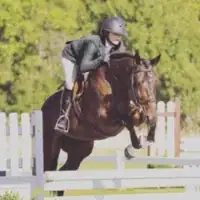 Kate JutagirKate Jutagir is an Equestrian Specialist, Hunter/Jumper Trainer, and the Owner of Blackhound Equestrian, a premier training barn located on 65 acres in Castro Valley, California. Originally designed to be a riding school used as a springboard for dedicated students into careers in the sport, Blackhound Equestrian has grown into a hunter/jumper training program for all levels focusing on providing a solid foundation needed for personal advancement in the sport. Kate has over 25 years of equestrian instruction and training experience. Her focus on developing horse and rider partnerships provides a complete equestrian education for both beginners and advanced riders alike.
Kate JutagirKate Jutagir is an Equestrian Specialist, Hunter/Jumper Trainer, and the Owner of Blackhound Equestrian, a premier training barn located on 65 acres in Castro Valley, California. Originally designed to be a riding school used as a springboard for dedicated students into careers in the sport, Blackhound Equestrian has grown into a hunter/jumper training program for all levels focusing on providing a solid foundation needed for personal advancement in the sport. Kate has over 25 years of equestrian instruction and training experience. Her focus on developing horse and rider partnerships provides a complete equestrian education for both beginners and advanced riders alike.
Equestrian Specialist & Trainer Very, very slowly. I would recommend reading lots of books about how horses are trained. Try to really understand that their reactions and behaviors can come from a few areas, including past abuse, physical pain, or an aggressive demeanor. Make sure the horse is comfortable and start from the basics.
Very, very slowly. I would recommend reading lots of books about how horses are trained. Try to really understand that their reactions and behaviors can come from a few areas, including past abuse, physical pain, or an aggressive demeanor. Make sure the horse is comfortable and start from the basics. -
QuestionHow do I load a horse that wont leave another horse's side?
 CrystalCommunity AnswerPut the horse that the horse likes in first and he will follow.
CrystalCommunity AnswerPut the horse that the horse likes in first and he will follow. -
QuestionWhat should I do if my horse spooks while I'm trying to bathe her?
 Community AnswerReassure her and try again. Move slowly. If she keeps spooking, let her loose and try again later.
Community AnswerReassure her and try again. Move slowly. If she keeps spooking, let her loose and try again later.
Warnings
- Only an experienced rider should work with spookable horses.⧼thumbs_response⧽
- Wrapping the horse's lead rope or reins around your hands can cause injury.⧼thumbs_response⧽
References
- ↑ Kate Jutagir. Equestrian Specialist & Trainer. Expert Interview. 31 March 2020.
- ↑ http://www.thehorse.com/articles/32345/study-t-touch-positively-accepted-by-saddle-horses
- ↑ http://annamullin.com/direct-and-indirect-rein-aids
- ↑ http://trailridermag.com/article/emergency-stop
- ↑ http://nasdonline.org/document/1043/d000837/approaching-catching-and-haltering-horses-safely.html
- ↑ http://www.thehorse.com/articles/32345/study-t-touch-positively-accepted-by-saddle-horses
- ↑ https://books.google.com.tr/books?isbn=1616735287
- ↑ Kate Jutagir. Equestrian Specialist & Trainer. Expert Interview. 31 March 2020.
- ↑ http://equinewellnessmagazine.com/emotions/
- ↑ http://www.alphahorse.com/horse-signs-unease.html
- ↑ http://nasdonline.org/document/1043/d000837/approaching-catching-and-haltering-horses-safely.html
- ↑ https://www.aspca.org/pet-care/virtual-pet-behaviorist/horse-behavior/training-your-horse
- ↑ https://ker.com/equinews/feeding-treats-horses/
- ↑ Kate Jutagir. Equestrian Specialist & Trainer. Expert Interview. 31 March 2020.
- ↑ http://www.horsechannel.com/horse-training/rogue-horse-behavior-2734.aspx
- ↑ Kate Jutagir. Equestrian Specialist & Trainer. Expert Interview. 31 March 2020.
